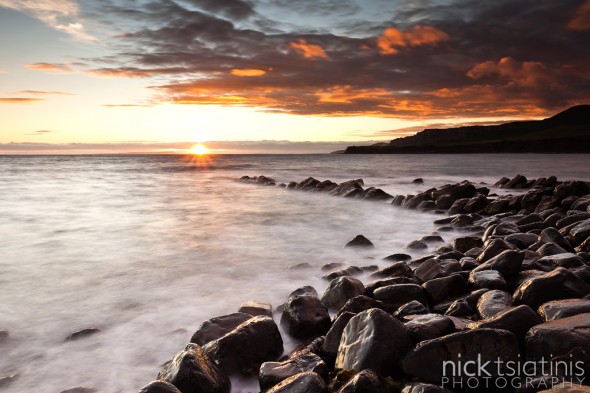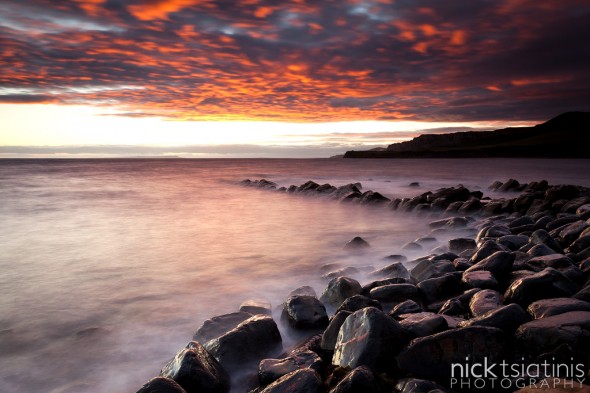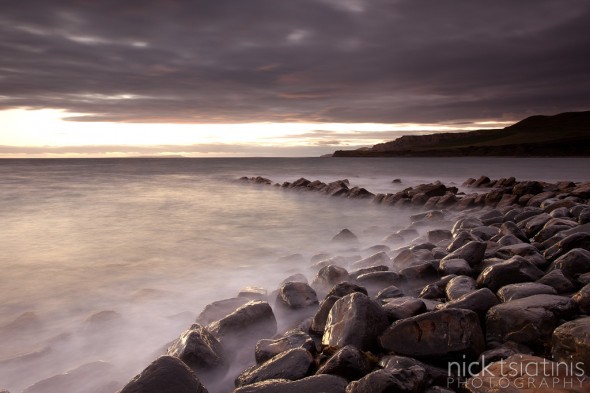10
2011Landscape photography and the art of timing – Kimmeridge…
All of the photographs in this article have the same composition. They’ve all had the same, minimal post processing treatment and none of them have had any computer trickery applied to them – yet they all look completely different. As photographers, these days we have a whole host of information available to us that allows us to find excellent locations (such as flickr), find out which direction the sun will be rising and setting and tell us exactly what time this will be happening (my favourite is the Photographer’s Ephemeris). There’s one thing we can’t dictate though, and that’s the weather conditions you’ll experience when you turn up at your chosen location. Look at the below statement.
There were 13 minutes between the first photograph on this page and the last. Thirteen whole minutes which completely transformed the overall scene.
At 6:40pm I took the photograph at the top of the page. I’d arrived at the location about 15 minutes earlier as my information told me that sunset was at 6:32pm – OK, I was cutting it a little fine, but I was tired and I’d been up at 6am for sunrise! When I arrived I noticed that there wasn’t much going on in the sky, there wasn’t too much cloud around, and there was a thin band obscuring the sun. So I thought I’d just wait a few minutes before getting my equipment set up. I then turned back to the scene, and in seconds it had transformed from lifeless to stunning. I took my tripod out, erected it at the side of the shore, guessing on the compositional position. Then, knowing my equipment I took out my camera with 17-40mm f4L lens, fitted my Lee 3 stop hard grad and 3 stop solid ND filters to the front of it (it’s a combination I use often so was confident that this would suffice), mounted my camera to the tripod, attached the remote release, quickly set up a composition which would take the eye from the rocks in the bottom left of the picture in a curve back round to the horizon and then took the picture. The sun had peeked out from between the thin band of cloud, causing a gorgeous bit of flare and some superb colours on the underside of the clouds. I was also rewarded with the delightful observation that my composition using the rocks as a lead-in actually leads the eye directly to the setting sun. Perfect! I was delighted with this image, and could have gone home happy at this point having taken one, single photograph.
From experience, I decided to wait around though and see what happened next, as once the sun dips beneath the horizon you can often get some spectacular lighting…
At 6:48pm, only 8 minutes after the first photograph, the sun had now dipped beneath the horizon and was working wonders on the clouds, which in turn were reflecting some stunning colours back onto the sea. As you can see, the composition is the same but the scene is somewhat different.
At 6:53pm the colour had gone. The scene had become ‘ordinary’. The clouds were no longer picking up the fantastic oranges and reds and instead were just a dull grey.
13 minutes is all it took.
So, what should you take away from this blog post? Be prepared. Know your equipment, know your subject and location, know your compositions and be ready for when nature gives you a break. And when nature isn’t smiling on you then just use the time as an excuse to brush up on the compositions, find the angles that give results, go away and then return another day and try again – it’s all part of landscape photography!
All of my landscape photography is available to purchase in the gallery, including the images above and others from my trip to Dorset in October 2011









